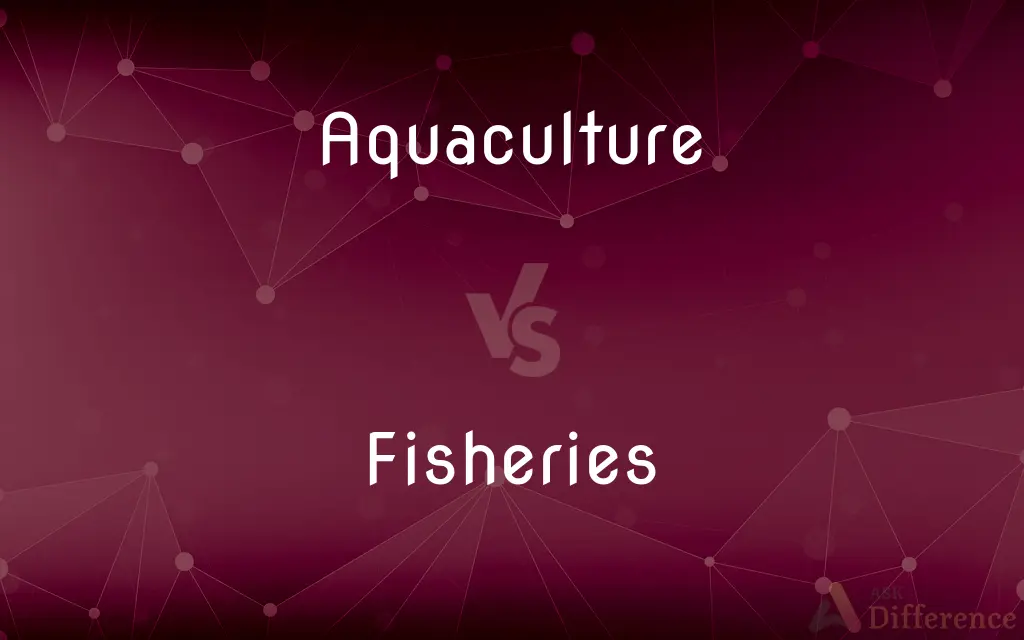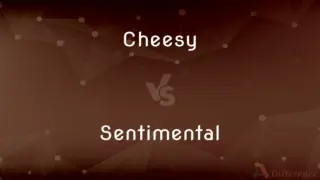Aquaculture vs. Fisheries — What's the Difference?
Edited by Tayyaba Rehman — By Fiza Rafique — Published on December 8, 2023
Aquaculture is the cultivation of aquatic organisms, while Fisheries involve capturing wild fish or raising fish commercially.

Difference Between Aquaculture and Fisheries
Table of Contents
ADVERTISEMENT
Key Differences
Aquaculture refers to the deliberate cultivation and farming of aquatic species, primarily for food. Fisheries can encompass both the capture of wild fish and the raising of fish for commercial purposes.
Aquaculture involves controlled breeding, rearing, and harvesting in freshwater, saltwater, or brackish environments. In contrast, Fisheries are businesses or facilities that catch or raise fish, either from the wild or through farming.
While Aquaculture typically aims to increase fish stocks or produce seafood at a larger and controlled scale, Fisheries are mainly concerned with ensuring the sustainability and viability of capturing or farming fish.
Aquaculture can be seen as a solution to the overfishing and depletion problems faced by Fisheries. On the other hand, Fisheries can provide essential insights into the natural behaviors and patterns of aquatic species that might be integrated into aquaculture practices.
The main goal of Aquaculture is to ensure a steady and controlled supply of aquatic food sources. Simultaneously, Fisheries focus on optimizing the use of aquatic resources while ensuring their long-term sustainability.
ADVERTISEMENT
Comparison Chart
Definition
Cultivation of aquatic species.
Capture or cultivation of fish.
Primary Focus
Raising and breeding.
Capturing wild or farming fish.
Environment
Freshwater, saltwater, or brackish environments.
Wild waters or controlled farming conditions.
Sustainability
Addresses overfishing concerns.
Can lead to overfishing if not managed.
Purpose
Ensure a steady seafood supply.
Optimize the use of aquatic resources.
Compare with Definitions
Aquaculture
The cultivation of aquatic animals and plants.
The growth of shrimp in aquaculture has expanded rapidly over the last decade.
Fisheries
Businesses or establishments concerned with fish capture.
The coastal town thrived due to its booming fisheries industry.
Aquaculture
Rearing of aquatic species under controlled conditions.
Aquaculture can help reduce the strain on natural fish populations.
Fisheries
Places where fish are reared for commercial purposes.
Some fisheries focus exclusively on raising tilapia for market sale.
Aquaculture
Production of seafood from hatchery fish and shellfish.
Many restaurants prefer to source their seafood from sustainable aquaculture practices.
Fisheries
The industry or occupation devoted to the catching, processing, or selling of fish.
Workers in fisheries often have early morning starts to ensure fresh catches.
Aquaculture
Farming of aquatic species in controlled environments.
Salmon raised in aquaculture are often sold as farm-raised salmon.
Fisheries
Organizations involved in harvesting or managing fish populations.
Sustainable fisheries aim to protect fish stocks for future generations.
Aquaculture
The practice of breeding and harvesting fish, shellfish, and aquatic plants.
Through aquaculture, we can ensure a consistent supply of oysters year-round.
Fisheries
Entities that engage in both catching wild fish and fish farming.
To diversify their income, many fisheries have incorporated aquaculture techniques.
Aquaculture
The cultivation of marine or freshwater organisms, especially food fish or shellfish such as salmon or oysters, under controlled conditions. Also called aquafarming.
Fisheries
The industry or occupation devoted to the catching, processing, or selling of fish, shellfish, or other aquatic animals.
Aquaculture
The cultivation of aquatic produce such as aquatic plants, fish, and other aquatic animals.
Fisheries
A place where fish or other aquatic animals are caught.
Aquaculture
The cultivation of aquatic animals, such as fish or shellfish, or of plants, such as seaweed, in a controlled and sometimes enclosed body of water. The term includes use of either salt or fresh water. It is a form of agriculture, but under water.
Fisheries
A fishing business.
Aquaculture
Rearing aquatic animals or cultivating aquatic plants for food
Fisheries
A hatchery for fish.
Fisheries
The legal right to fish in specified waters or areas.
Fisheries
Plural of fishery
Common Curiosities
What is aquaculture primarily concerned with?
Aquaculture primarily concerns the cultivation and farming of aquatic species.
Can fisheries involve the farming of fish?
Yes, fisheries can include facilities that raise fish for commercial purposes.
Which practice, aquaculture or fisheries, can lead to overfishing if not managed?
Fisheries, especially those that capture wild fish, can lead to overfishing if not managed sustainably.
Are all fisheries involved in catching wild fish?
No, some fisheries focus exclusively on fish farming.
Is aquaculture an alternative to traditional fisheries?
Yes, aquaculture is seen as an alternative to address overfishing concerns in traditional fisheries.
How do fisheries obtain fish?
Fisheries obtain fish either by capturing them from the wild or by raising them commercially.
Where can aquaculture take place?
Aquaculture can occur in freshwater, saltwater, or brackish environments.
Can aquaculture practices be integrated into fisheries?
Yes, many fisheries incorporate aquaculture techniques to diversify and enhance their operations.
How can aquaculture impact local ecosystems?
If not managed properly, aquaculture can lead to pollution, habitat alteration, and introduction of non-native species.
Are fisheries always commercial businesses?
Most fisheries are commercial, but there can also be community-based or subsistence fisheries.
Do fisheries always deplete fish stocks?
No, sustainable fisheries manage their practices to ensure long-term viability of fish stocks.
How does aquaculture address sustainability?
Aquaculture provides a controlled environment to raise aquatic species, reducing pressure on wild populations.
What's a significant advantage of aquaculture?
Aquaculture ensures a steady and controlled supply of aquatic food sources.
What challenges do fisheries face today?
Fisheries face challenges like overfishing, habitat destruction, and climate change impacts.
How do fisheries contribute to local economies?
Fisheries can generate jobs, income, and support related industries like boat manufacturing and seafood processing.
Share Your Discovery

Previous Comparison
Combinational Circuit vs. Sequential Circuit
Next Comparison
Cheesy vs. SentimentalAuthor Spotlight
Written by
Fiza RafiqueFiza Rafique is a skilled content writer at AskDifference.com, where she meticulously refines and enhances written pieces. Drawing from her vast editorial expertise, Fiza ensures clarity, accuracy, and precision in every article. Passionate about language, she continually seeks to elevate the quality of content for readers worldwide.
Edited by
Tayyaba RehmanTayyaba Rehman is a distinguished writer, currently serving as a primary contributor to askdifference.com. As a researcher in semantics and etymology, Tayyaba's passion for the complexity of languages and their distinctions has found a perfect home on the platform. Tayyaba delves into the intricacies of language, distinguishing between commonly confused words and phrases, thereby providing clarity for readers worldwide.












































